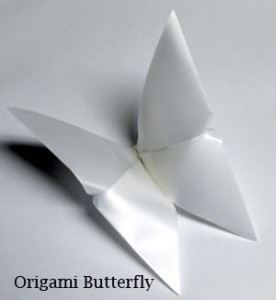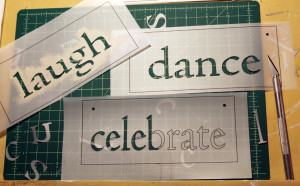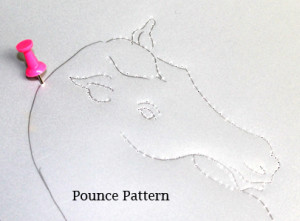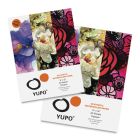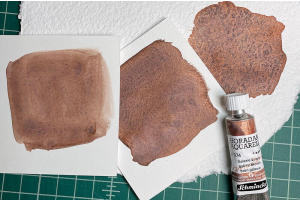We use cookies to make your experience better. To comply with the new e-Privacy directive, we need to ask for your consent to set the cookies. Learn more.
Cheap Joe’s Art Stuff Art Blog
Tips, Tricks, Thoughts, and inspiration from across the art spectrum.
Mother Necessity Meets Yupo


The old saying, "Necessity is the mother of invention", has been around since the 1600's. Still true today as then, necessity sparks our minds to think of ways to create a solution to our need. There seem to be discoveries of all types made every day in the art world. New materials, converted materials, new pigments, new tools, new brushes, and, especially, new surfaces to paint on. Many new alternative surfaces to traditional wood and canvas, have been developed and accepted into the art community as viable substrates in which to create on. Arches Oil Paper, NatureCore paint boards, Joe's Prime Extra Fine Art Board, Ampersand Scratchbord and Aquabord, Terraskin, Yupo Watercolor Paper, and many more, provide artists with a vast choice of suitable supports for all mediums. The applications are limitless. Although, most of these surfaces have seemingly one purpose, as a substrate, there are those painting

materials that provide a multitude of purposes useful to artists. Of those, perhaps, is my favorite, Yupo Watercolor Paper. Yupo is an alternative synthetic paper that was invented to address the need to replace tree pulp paper to help preserve our tree populations around the world. We need a treeless paper and Yupo Watercolor Paper is a solution. For over 40 years, the Yupo Corporation has been researching and developing its invention for product packaging, advertising, and largely, printed media. They continue to strive to replace the tree pulp papers that find their way into a landfill on a daily basis. Yupo is completely earth friendly and as other materials have been "borrowed" from larger markets, artists have finally recognized it as a versatile art surface. Yupo comes in many different forms. Heavy weight, Medium weight, Light weight, Translucent Light weight, and Translucent Heavy weight. Professional artists rave over the results of painting on Yupo. Artists like Mark Mehaffey, the Yupo Queen, Taylor Ikin and the Yupo Princess, Carol Anne Sherman have been using it for years. There is no doubt that Yupo is increasing in popularity as a painting substrate, however, there are other practical reasons to keep this unique synthetic paper on hand, as well.
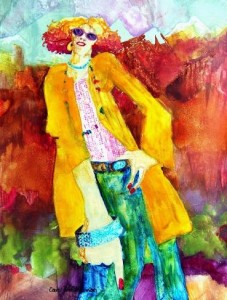
Here are a few of my favorite uses for Yupo Watercolor Paper!
Origami - Light weight Yupo is great for origami folding. It is durable, waterproof and will not tear. It can be decorated with markers or paint before or after creating your art. Yupo can be painted or decorated with Sharpie Markers.
Stencils - You can run Yupo through your printer to create custom stencils. These are great to use on your journal pages, make signs, or stencil on t-shirts. 1. Typeset your word in a program like Adobe Illustrator. 2. Print onto the Yupo and allow ink to dry. 3. Spray with Golden Archival Matte Spray Varnish and allow to dry. 4. Cut out with an X-Acto No. 1 Precision Knife. You must leave spaces on letters with open areas like an "O" to connect the middle area. [caption id="attachment_7823" align="aligncenter" width="300"] Zoltan Szabo designed these brushes for watercolor painting. They are also great for stenciling![/caption] 5. Apply acrylic paint through the stencil to wood, canvas, fabric, paper with a stiff bristle brush. I used a Zoltan Szabo Bristle Slant 1 1/2" flat. The short bristles allowed me to apply the paint with a tapping technique for less seepage under the stencil edges.
Pounce patterns have been used in the furniture industry for years! Pounce Patterns - Pounce patterns are used to transfer production artwork onto large pieces of furniture which are, then, hand painted. 1. Draw the line pattern onto the Heavy weight or Medium weight Yupo.
A push pin is a perfect tool to make pin holes in the Yupo Watercolor Paper. Punch along the pattern lines with a push pin to create a series of series of holes that represent the image.
The pattern is neatly transferred onto the painting surface and can be used over and over again.[/caption] 3. Use carpenters chalk in a fabric bag to pounce and transfer the chalk onto the painting surface. Now, the pattern is visible on the painting surface and may be easily followed and duplicated on multiple surfaces. The chalk will be absorbed into the paint. Some colors stain the surface, especially red. Use a color of chalk closest to your paint design. Blue is my favorite.
Other Fun Uses! Sun Catchers - Paint a design with watercolors, transparent acrylics, or markers on Translucent Yupo. Frame design between two pieces of glass and hang in a sunny window. Colors may eventually fade, so just enjoy it for what it is!
Mono Printing - Paint a design on Yupo in reverse or abstractly with watercolor, tempera, American Journey Artists' Watercolor Sticks, or other water soluble mediums, place paper on top of wet design, smooth with brayer, and lift to transfer design to paper as a monoprint. Try wetting the paper before placing on the Yupo design.
Luminaries - Using the same technique as with the pounce patterns, punch holes in a sheet of Yupo Watercolor Paper, Translucent in a decorative design. Roll the Yupo paper around a shallow can (such as a tuna can) or other flame resistant container and secure with glue or tape. Place a small votive candle in the can and light it to see the glow of the design. (do not knock over or leave unattended). Try seasonal designs for Halloween, Christmas, or Valentine's Day! It's always great to find such a versatile material like Yupo. The possibilities are limitless. New art stuff is being discovered and introduced every day. It is our task, as artists, to test drive these new discoveries and put them to the test. If, along the way, we find iy necessary to re-invent, re-purpose, manipulate, alternate, fabricate, the materials to fit our needs as we are creating, then, so be it! Have some other uses for Yupo? Or maybe for other versatile art materials? Leave a comment and let us know! Hope you have a Yupo Great Day! Come on, and put on your creative cap and let's go!


